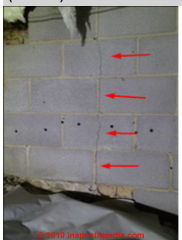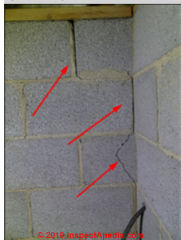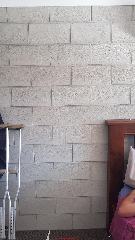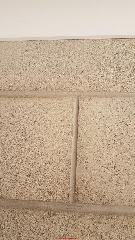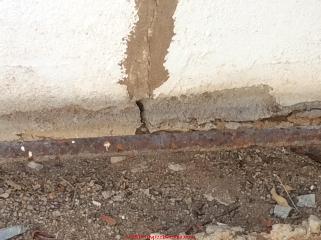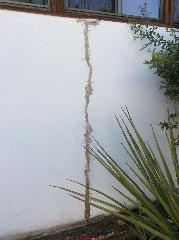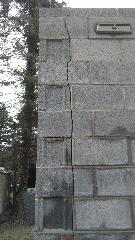 Vertical Cracks in Masonry Block FAQs
Vertical Cracks in Masonry Block FAQs
Wall or Foundation Vertical Crack Q&A
- POST a QUESTION or COMMENT about damaged concrete block foundations
Q&A about vertical cracks in block foundations & walls.
This article series describes and evaluates vertical cracking that may appear in some concrete block or masonry block walls or foundation walls. Some readers may use the term "cinder block" - an older form of masonry block wall construction.
InspectAPedia tolerates no conflicts of interest. We have no relationship with advertisers, products, or services discussed at this website.
Vertical Crack FAQs - Block Foundations & Walls
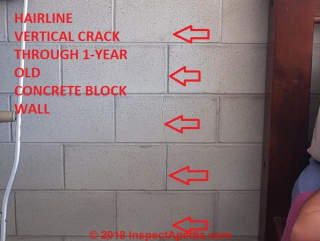 These questions and answers about vertical cracks in masonry block foundations or walls were posted originally at VERTICAL CRACKS in BLOCK WALLS - please be sure to read the diagnostic and repair advice given there.
These questions and answers about vertical cracks in masonry block foundations or walls were posted originally at VERTICAL CRACKS in BLOCK WALLS - please be sure to read the diagnostic and repair advice given there.
[Click to enlarge any image]
On 2019-12-15 by Anonymous
It would be helpful to have a guess at whether the crack is actually new or rather simply not noticed previously.
If new then something's certainly going-on that needs diagnosis and perhaps action.
On 2019-12-15 by Nina
Thank you so much for the information. The home was inspection last year and didn't have the corner crack noted. Then I got it inspected this year and found it. I am looking to purchase home and wanted a some insight.
On 2019-12-14 by (mod) -
Nina
That step crack pattern (in the brick (veneer?) wall is typical of settlement over a high point (e.g. over a buried rock or pipe over which a footing has cracked and settled); if it's ongoing repair may be needed;
A vertical foundation crack in a block foundation but not near a foundation corner is often caused by the same sort of movement.
Conversely, if there are vertical cracks just at the corners of a foundation wall such as shown at our page top, often that means that the whole wall is leaning out - or its footing is tipping or rotating.
Our discussion and photos underscore the important point that "inspecting" a home by e-text and a few photos is, by definition, very limited and often incorrect.
We can only see what you see and photograph; in a lifetime of building inspection I have found when I've been able to inspect a building or site about which we had prior owner-observations and discussion there was virtually always important additional data (and often different conclusion) - that's an argument for deciding to bring an experienced person on-site; they may be no smarter than you but they've got more experience. (Hopefully).
For example in your brick photo I am only assuming that we're looking at a brick veneer wall; where is it on the building? High, low, at a window or door? How do those cracks relate to other signs of movement in the structure?
You don't need to answer these questions they're just examples of our limitations.
On 2019-12-14 by Nina Vert
There is another down spout on other side by the cracks. The other interior crack in crawl space is under front door behind stoop.
I believe that is the gas line to the tank located outside.
There is also a down spout by the crack. The other interior crack in crawl space is right behind front door stoop.
On 2019-12-14 by (mod) -
Let's see the cracks on the outside.
That's a long right-hand addition with roof draining into bushes (2 downspouts) by the foundation and the original house also has roof drainage spilling by the foundation at that original house "front" left corner, though perhaps into an area that slopes away from the structure;
If gutters are spilling by the foundation along the front of the home - along that RH addition - that could contribute to footing settlement (or to frost heave cracking but your crack pattern looks more like settlement from my VERY LIMITED view)
In your original photo there's something - a water pipe or electrical line or ? - passing through the foundation; what's buried outside at that location?
On 2019-12-14 by Nina
Outside wall
The older section of the home is the left side and addition is the right horizontal section. The crack in showing in the bottom left from corner on inside with horizontal and step cracks on the outside.
On 2019-12-14 by (mod) - guessing at crack damage in older home block foundation with brick veneer cracaks
Nina
I'd need to see quite a bit more to have a confident opinion but it's certainly possible that
- roof drainage is spilling by the foundation causing settlement or footing rotating or tipping
- the addition was bolted or otherwise connected to the building and is settling, pulling the original foundation wall and causing cracking
At the very least one would want to see the home from the outside and to relate the facing and right-side walls in your photo to the home from exterior to see which wall is moving in what direction.
On 2019-12-14 by Nina
The house was built in 1959. It seems to have happened in the last year and home was built on the slope and added to in 2000.
On 2019-12-14 by (mod) -
Nina that crack pattern usually means that one of the two walls or its footing is settling or tipping.
The urgency of repair will depend on the age of the home and the period of time over which that crack damage has appeared.
Was part of the foundation or footing built on the down-slope side of a sloping lot or constructed on fill?
On 2019-12-14 by Nina
Home has a crack in cinder block crawl space on lowest grade of home in corner. Another crack on the wall joining the wall with corner crack. House is located in central North Carolina. Are these big issues or minor. Thanks
On 2019-01-06 by (mod) - hairline straight vertical crack cuts through concrete blocks at wall center
ok Amanda I see a very fine vertical crack in the center of your photo, cutting through a block, not just in mortar joints.
As we've marked with red arrows in an excerpt from your last photo, the hairline vertical crack follows vertical mortar joints and cracks through the center of the concrete blocks below those mortar joints as well.
In the topic home for this crack pattern,
VERTICAL CRACKS in BLOCK WALLS, you will find a photo of a similar crack though one that is a bit wider. There I make this comment:
I think that this wall cracked in its center as a result of expansion or contraction caused by significant changes in the moisture content of these blocks - but I'm not certain.
Yours is a one year old new home. You could be seeing a similar crack cause.
It would be helpful to know
- the city and state or province of the home,
- the height of backfill, and
- the history of construction, weather, time of year,
- moisture exposure,
- or any notes about just how wet the foundation was when constructed.
On 2019-01-06 by Amanda - more photos of vertical crack in foundation wall
Amanda here, I've just added another photo for my question. [Click to enlarge any image]
On 2019-01-01 by (mod) - look for cracks through blocks as well as at mortar joints
And your photos I couldn't see any cracks in the nlicks themselves
Are you referring to a mortar joint that was not filled with mortar between abutting concrete blocks?
On 2019-01-01 by tymatbo1976 Amanda - multiple cracks inside and out in the blockwork of a 12-month old core-filled concrete block wall
Hi, have 12 month old core filled block home. There are multiple cracks inside and out in the blockwork.
There is reinforced steel throughout the walls. Is this a foundation issue?
Or is it something to worry about.
On 2018-04-05 by (mod) - serious footing rotation or settlement at corner of concrete block wall
 Evan
Evan
If you're describing a vertical crack in the block wall I suspect that the footing under your wall either heaved or settled in a pattern that engineers typically call "rotation" - meaning that the footing may have tipped outwards, causing the wall to "rotate" or lean outwards.
It's very unlikely that you could pull the entire wall Back Together by bolting and wenching more likely you would create more damage to the wall.
You would have to employ a method such a slab jacking trying to support and level of footings.
You should pay attention to keeping water away from the footings, making sure the footings are below the frost line, and then are you are article series on patching cracks in concrete block walls.
Watch out: If the walls are sitting on top of a monolithic slab that incorporates both the interior floor slab and the slab footings, you need to inspect the slab closely for cracking or breaks around the perimeter.
If this were my wall, before continuing construction I'd have an expert assess the cause of movement, the condition of the footing, and thus to help me decide if we need to make footing repairs to prevent further movement.
It's less costly to do this investigation and repair now than it would be after the building construction is complete.
On 2018-04-04 by evan
So had a tall concrete block wall put in to build a parking pad. Over the winter due to freeze defrost I have this lovely crack from top to bottom. I will be having the pad concreted so no more water will get down there but I'd like to shore up the crack.
Is there anything I can do to pull the crack back together instead of us filling it in?
Can I bolt into the blocks on either side and pull them together slowly and then patch it?
Any advice would be great.
While we on the topic the pad is 20 x 30 concrete or paving?
On 2018-01-11 by Casseybug - block wall heave might be blamed on root damage?
 Will do. Question is in my mind..if we DON"T remove Pyracanthas now, and we do have crack movement, spreading, we won't know if it is the ground or the plant. Right?
Will do. Question is in my mind..if we DON"T remove Pyracanthas now, and we do have crack movement, spreading, we won't know if it is the ground or the plant. Right?
So it seems we should have it removed, at least at the trunk/ground (roots god knows how much underground, will leave them in the ground ) at least we would be removing from the equation.
On 2018-01-09 by (mod) - monitor cracks for ongoing movement
Sounds fine. Do keep me posted.
I'd also like to see a photo of the crack monitor when you have it in place.
On 2018-01-09 by Casseybug
Mod, thank you for your comments-very appreciated. We will do 12 months of wall crack gauge and go from there. Seems the smartest thing to do.
On 2018-01-08 by (mod) - tree roots can damage foundations
I Sit Corrected
That tree stump looks a lot fatter and bigger in your last photo.
I like the idea of using a crack gauge but you might want to watch it for a year so you have gone through all of the seasons where you live.
By your note the crack has been in this location and condition since 1990 - nearly 30 years. If you see no movement in the gauge after a year you can feel more confident that there is no evidence at all of significant ongoing foundation movement.
Nobody, however, with much experience, is going to have the nerve to absolutely guarantee that there is no active foundation movement in a building. For example there still could remain unusual weather variation, temperature extremes, local flooding, or other external causes that could cause your foundation to move.
It's unlikely, however, that a small vertical crack is causing significant movement in the structure such that you'd be afraid of a sudden catastrophic collapse.
On 2018-01-08 by Casseybug
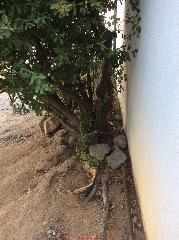 Thank you for your input. I"m including another shot of small tree, just in case.
Thank you for your input. I"m including another shot of small tree, just in case.
Oddly, a similar model duplex has same tree near his foundation, almost same spot, and he has a vertical crack, but just in the stucco.
Ours you can see some daylight.
If I put on a crack gauge now for say 6 months, and see no movement, would that be enough guarantee it is not active? in which case I would have it professionally sealed up. Thoughts?
On 2018-01-08 by Casseybug
HI, thank you for any input, my main question was the first post, and then added photos.
By the way, our HOA will not get involved because once porch was enclosed, they will have no responsibility, since "compromised" with a change to original structure.
We have no idea if crack was there before new roof/windows or not. Work was done by a local outfit long gone, and was approved by HOA.
On 2018-01-08 by (mod) -
Cassey
In your photo above I don't see a tree large enough that I would expect that to be the cause of the rather straight and reported-old vertical foundation crack in your home.
More likely the foundation or its footing settled over a single point, possibly at time of or soon after construction.
If you patch the crack and see it opening anew or opening further, then some investigation would be in order. Else I'd seal and paint stop there.
On 2018-01-08 by Casseybug
Pyracantha side shot
Close up exterior, seems to show patio concrete pad crack, at bottom, and then thinner vertical crack running up through the wall. Has been cosmetically patched (oh great job) by HOA maintenance.
On 2018-01-08 by Casseybug - vertical wall crack, stucco over cement block, Green Valley Arizona
 1964 single level duplex, stucco over cement block house in Green Valley, AZ.
1964 single level duplex, stucco over cement block house in Green Valley, AZ.
Outside patio had roof and 4' wall on two sides: was rerroofed, enclosed as an AZ room, and bank of alum windows along the top 30 years ago.
Aunt moved in 1990 and said there was always a vertical wall crack in back wall. Pine wood framing is rotting and we need to replace, but not sure if crack is serious or not. One foundation expert says we need 3 tiers 8' down along the 20' long side, where crack is, for 6K.
Another adobe wall/house specialist says it is old settling crack and not to worry. Just do a good stucco repair. We have sat on this for two years, and now finally placing a wall crack gauge to make sure it is not active.
There is also a large pyracantha tree at base, 16"? wide root, at foundation and roots under. this might be cause of our problems?
Any help suggested, just don't know who to believe. Uploading several images, but can't tell if they are actually being included.
On 2017-12-11 by Rich R
Have a couple blocks that are cracked vertically in the garage. Maybe others around the house but wouldn't know because of vinyl siding. Anything to worry about?
On 2017-12-04 by (mod) - straight 1/8th " vertical crack in and in between 6 of 11 basement blocks, beginning at the top.
John,
I have to start with the apology that it should be obvious that our on-site Foundation expert, Foundation contractor, Foundation engineer or even an experienced home inspector would most likely see evidence of the type of movement and is cause that I can't snow from a brief text message.
If my understanding is correct that the crack is in an interior wall so it's that there's no leak problem ceiling is not an urgent concern.
I would focus on understanding the cause of the movement such as a tipping Foundation footing, and I would want to monitor the crack for a sign of ongoing movement. If there is ongoing movement that the need for a repair is more likely.
As part of diagnosis, I might also drop a plumb line and measure to see if the wall is out of vertical plumb.
On 2017-12-04 by John
I have a straight 1/8th " vertical crack in and in between 6 of 11 basement blocks, beginning at the top.
The crack is about 7" from a 90 degree angle corner There is a ground-level, cement garage floor on the other side. What should be done?
johnwil@gmail.com
There is a vertical crack, between or in, the top six of 11 blocks, in the basement wall about 7.5" from the the corner where they meet at a 90 degree angle. At the top of both walls there is a cement garage floor the other side. What to do?
...
Continue reading at VERTICAL CRACKS in BLOCK WALLS or select a topic from the closely-related articles below, or see the complete ARTICLE INDEX.
Or see these
Articles on Vertical Cracks & Movement in Foundations
Suggested citation for this web page
VERTICAL CRACKS in BLOCK WALLS FAQs at InspectApedia.com - online encyclopedia of building & environmental inspection, testing, diagnosis, repair, & problem prevention advice.
Or see this
INDEX to RELATED ARTICLES: ARTICLE INDEX to BUILDING STRUCTURES
Or use the SEARCH BOX found below to Ask a Question or Search InspectApedia
Ask a Question or Search InspectApedia
Questions & answers or comments about damaged concrete block foundations: causes, crack & movement patterns, diagnosis, repair, inspection procedures..
Try the search box just below, or if you prefer, post a question or comment in the Comments box below and we will respond promptly.
Search the InspectApedia website
Note: appearance of your Comment below may be delayed: if your comment contains an image, photograph, web link, or text that looks to the software as if it might be a web link, your posting will appear after it has been approved by a moderator. Apologies for the delay.
Only one image can be added per comment but you can post as many comments, and therefore images, as you like.
You will not receive a notification when a response to your question has been posted.
Please bookmark this page to make it easy for you to check back for our response.
Our Comment Box is provided by Countable Web Productions countable.ca
Citations & References
In addition to any citations in the article above, a full list is available on request.
- In addition to citations & references found in this article, see the research citations given at the end of the related articles found at our suggested
CONTINUE READING or RECOMMENDED ARTICLES.
- Carson, Dunlop & Associates Ltd., 120 Carlton Street Suite 407, Toronto ON M5A 4K2. Tel: (416) 964-9415 1-800-268-7070 Email: info@carsondunlop.com. Alan Carson is a past president of ASHI, the American Society of Home Inspectors.
Thanks to Alan Carson and Bob Dunlop, for permission for InspectAPedia to use text excerpts from The HOME REFERENCE BOOK - the Encyclopedia of Homes and to use illustrations from The ILLUSTRATED HOME .
Carson Dunlop Associates provides extensive home inspection education and report writing material. In gratitude we provide links to tsome Carson Dunlop Associates products and services.


